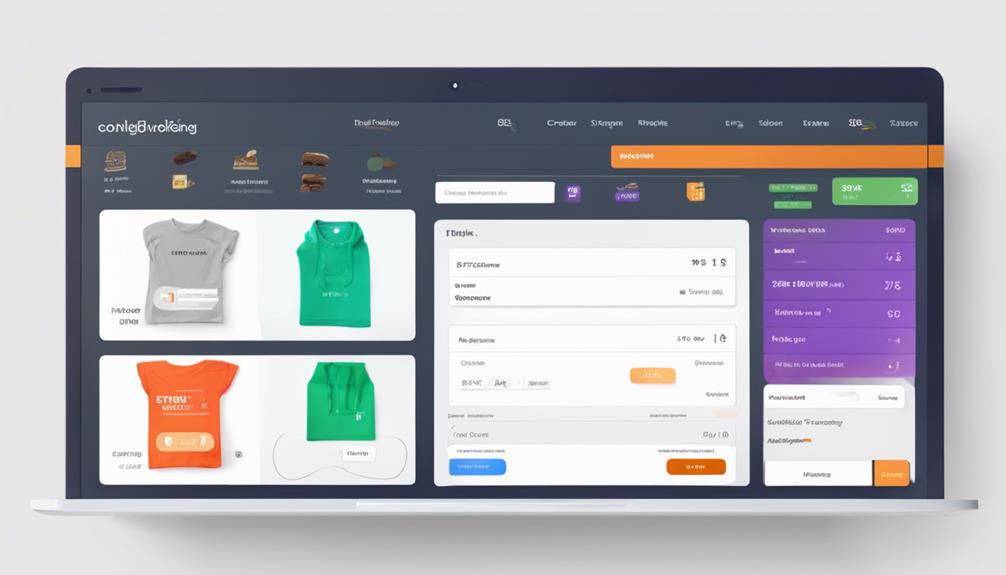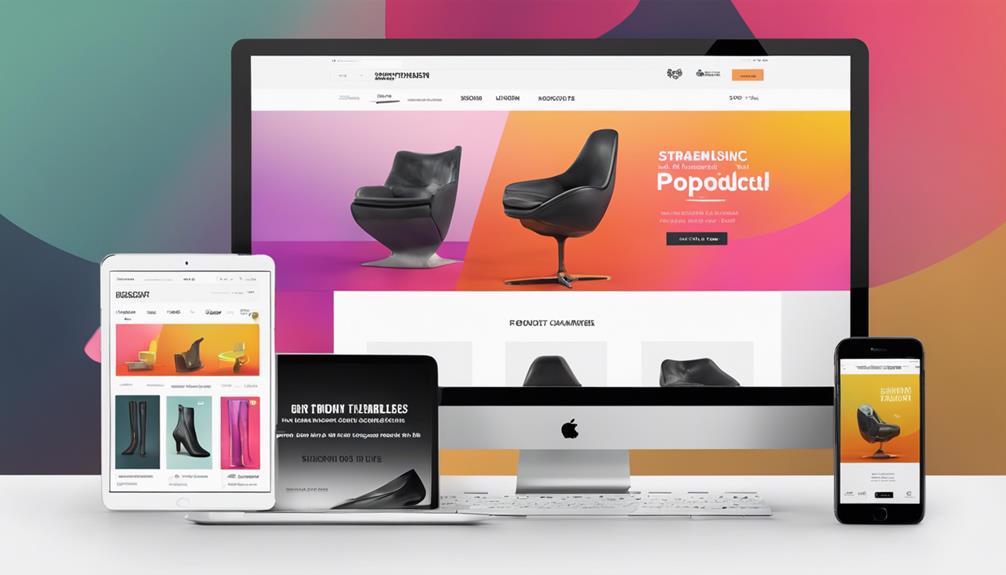You might think your e-commerce site is doing well, but have you considered how UX design could elevate your sales even further? By focusing on optimizing site navigation and streamlining the checkout process, you can reduce friction that often leads to abandoned carts. Ensuring mobile responsiveness is crucial as more customers shop on their phones. But it doesn't stop there—persuasive design elements like social proof and clear call-to-actions play a significant role in motivating purchases. And let's not forget about page load speed, which, if neglected, can sabotage your revenue. Curious about how to implement these strategies?
Optimize Site Navigation
In the realm of e-commerce, optimizing site navigation is essential to ensure a seamless user experience. You need to create a path that guides your users effortlessly from point A to point B. Start by implementing a clear and concise menu structure. Your main navigation bar should highlight key categories and subcategories, allowing users to find what they're looking for without frustration. Use familiar terms to minimize confusion and maximize efficiency.
Think about incorporating a search bar that's easily accessible and capable of handling broad and specific queries alike. Users appreciate an intuitive search function that provides relevant results quickly. Remember, speed is crucial. A delay can mean the difference between a sale and an abandoned cart.
Visual hierarchy plays a pivotal role here. Make sure your most important categories are prominent, using contrasting colors or larger fonts to draw attention. Consider using breadcrumb trails to help users track their journey through your site, making backtracking simple and stress-free.
Don't overlook mobile navigation. With the surge in mobile shopping, ensure your site is fully responsive. Optimize touch targets for easy tapping and consider using collapsible menus to maintain a clean, organized appearance.
Streamline Checkout Process

Having guided users through a well-structured site, the next step is to simplify the checkout process to secure those sales. The checkout experience is where potential buyers often become hesitant, so make it seamless and intuitive. Here's how you can streamline this crucial step:
1. Minimize Steps: Aim to keep the checkout process as short as possible. Consolidate information into as few pages as you can while maintaining clarity. Every additional click is an opportunity for the customer to abandon their cart.
Use a progress indicator to visually guide them through the process, ensuring they know exactly how close they're to completing their purchase.
2. Guest Checkout Option: Not everyone wants to create an account just to make a purchase. Offering a guest checkout option can significantly reduce friction.
Make sure this option is clearly visible from the start to cater to those who prioritize speed and convenience over account creation.
3. Auto-fill and Error Notifications: Enhance efficiency by enabling auto-fill for forms, allowing users to input their information quickly.
Pair this with real-time error notifications to prevent them from encountering frustrating validation errors after submission. Highlight incorrect fields immediately with clear instructions on how to correct them, turning a potential frustration into an easy fix.
A streamlined checkout process isn't just about reducing steps; it's about crafting an experience that feels effortless and engaging.
Enhance Mobile Responsiveness

A seamless mobile experience is crucial in today's e-commerce landscape, where users often browse and shop on their smartphones. You need to ensure your online store is fully optimized for mobile devices to capture and retain these users.
Start by implementing a responsive design, which automatically adapts your site's layout to fit various screen sizes. This approach eliminates the frustration of zooming in and out, ensuring that navigation remains intuitive and hassle-free.
Pay close attention to the load times of your mobile site. Slow-loading pages can drive your potential customers away. Compress images, leverage browser caching, and minimize server response time to keep your site speedy. Remember, every second counts in keeping users engaged.
Focus on touch-friendly navigation. Design buttons and links that are easy to tap without accidentally clicking nearby elements. Space them out adequately and ensure they're large enough to accommodate different finger sizes. This attention to detail enhances the user's experience, making it easier for them to interact with your site.
Simplify your mobile layout by prioritizing content essential for conversion. Use a clean, uncluttered design that guides users toward completing their desired actions, like adding items to their cart or making a purchase. A streamlined experience on a smaller screen can significantly impact user satisfaction and drive sales.
Lastly, always test your mobile site on various devices. Real-time testing allows you to identify and rectify any issues, ensuring your site delivers a flawless experience across all platforms.
With these strategies, you'll enhance your e-commerce sales through effective mobile responsiveness.
Utilize Persuasive Design Elements

Crafting an e-commerce site that captures your audience's attention requires more than just aesthetics; it hinges on the strategic use of persuasive design elements. By integrating these elements effectively, you can guide users toward making purchasing decisions, thereby boosting your sales.
Here's how you can implement persuasive design to transform your e-commerce platform into a conversion powerhouse:
1. Social Proof: Incorporate customer reviews, testimonials, and ratings prominently on your product pages. This creates trust and reassures potential buyers that others have had positive experiences with your products.
Consider a user-friendly layout that encourages customers to share their feedback and engage with your community.
2. Scarcity and Urgency: Use countdown timers, low-stock alerts, or limited-time offers to create a sense of urgency. These visual cues can motivate users to act quickly rather than postponing their purchasing decision.
Make sure these elements are visually distinct yet harmoniously integrated into your design, so they capture attention without overwhelming the user.
3. Clear Call-to-Actions (CTAs): Your CTAs should be visually striking and straightforward. Use contrasting colors and concise language to make them stand out.
Phrases like "Buy Now" or "Add to Cart" should be easy to locate and simple to understand. Position them strategically in spots where users are most likely to make a decision.
Improve Page Load Speed

While persuasive design elements can captivate and convert visitors, the effectiveness of these strategies depends heavily on how swiftly your e-commerce site loads. Imagine a potential customer excitedly clicking on a product link, only to be met with a spinning wheel of frustration. Studies reveal that a mere one-second delay in page load time can lead to a 7% reduction in conversions. You can't afford to lose those sales.
To improve your page load speed, start by optimizing your images. Use formats like JPEG for photos and PNG for graphics with fewer colors. Compress these images without compromising quality using tools like TinyPNG or ImageOptim. This simple step can drastically reduce load times.
Next, take a look at your site's code. Minify CSS, JavaScript, and HTML by removing unnecessary spaces and comments. This streamlines your site's structure, helping it load faster. Employ tools like Google's PageSpeed Insights to identify specific areas for improvement.
Don't forget about server response times. Choose a reliable hosting provider, as a slow server can bottleneck your site's performance. Consider a Content Delivery Network (CDN) to distribute your content efficiently across various geographical locations, ensuring users get the fastest load times possible.
Lastly, enable browser caching. This allows returning visitors to load your site faster, as their browser stores static files locally.
Conclusion
Picture your e-commerce site as a beautifully orchestrated journey. With intuitive navigation, your customers glide effortlessly between pages. The streamlined checkout process is a gentle breeze, leading them smoothly to their destination. On mobile, your site dances gracefully, adapting to every screen. Persuasive design elements act like charming street performers, capturing attention and guiding decisions. Finally, with lightning-fast page loads, the experience is seamless. By embracing these enhancements, you're crafting a digital landscape where conversions flourish and sales soar.


Leave a Reply